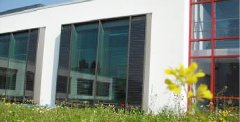Jun 24 2009
Hydro's new test center for aluminum building solutions, inaugurated in Germany on Tuesday, is a true showcase of building-integrated photovoltaic systems - with eco-efficiency the result.
 'TEmotion': The new test center has building-integrated photovoltaics in its TEmotion windows, to generate energy.
'TEmotion': The new test center has building-integrated photovoltaics in its TEmotion windows, to generate energy.
Most of the photovoltaic elements are mounted on the rooftop of the test center, which is not unusual in Germany. In fact, the application is widely used.
Having building-integrated photovoltaics (BIPV) in windows, however, is not as common. In the new building, Wicona is using its own TEmotion systems, an in-house concept, with integrated photovoltaic cells. Wicona is one of Hydro's brands for aluminium-based building solutions.
Teamwork
The Wicona team responsible for the test center has worked closely with the Solar organization of the Hydro Building Systems' sector on the window application and the integration of the photovoltaic modules.
Specialists in solar energy integration, HBS Solar executed several analyses, taking into account specific elements of the test center site, like geographical coordinates, orientation, inclination and shades. This work led to the selection of photovoltaic cells, inverters and electrical layouts, in order to optimize the production.
The modules were installed at the end of May.
Today, the capacity of the BIPV TEmotion modules - they are connected to the power grid in Germany - is expected to reach 900 kilowatt hours per year. This is 90 percent of the energy required to operate the modules.
"Or goal is to be electrically self-sufficient with the TEmotion BIPV, and we are looking at this as an excellent test of the system," says Christine Fabé, communication manager of HBS Solar.
She says HBS Solar will monitor the consumption of the operating TEmotion facade modules at the site in Bellenberg, Ulm, and then work to improve the system from there.
Energy-plus concept
The Bellenberg building's rooftop BIPVs are expected to contribute some 40,000 kilowatt hours per year. This electricity is the basis for Wicona's energy-plus concept, and enables the systems brand to call its new test center a "zero energy building."
Operation of the building will require about 30,000 kWh/year, says Wicona Brand Center marketing manager Philipp Müller, adding that this figure includes any electronic applicances in the existing building as well as in the new test center.
The remaining amount - or, 10,000 kWh/year - is estimated to meet the building's heating and artificial lighting needs.
He says "the contribution of the TEmotion windows is a fantastic demonstration of BIPV in a very attractive architectural design. We expect to see more solutions like this in future building envelopes."